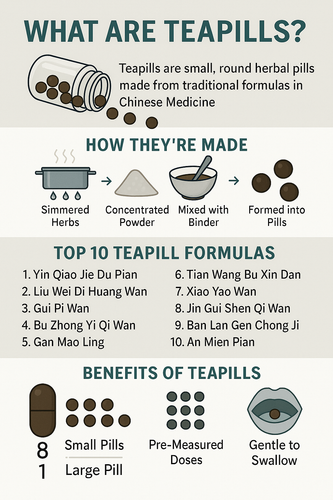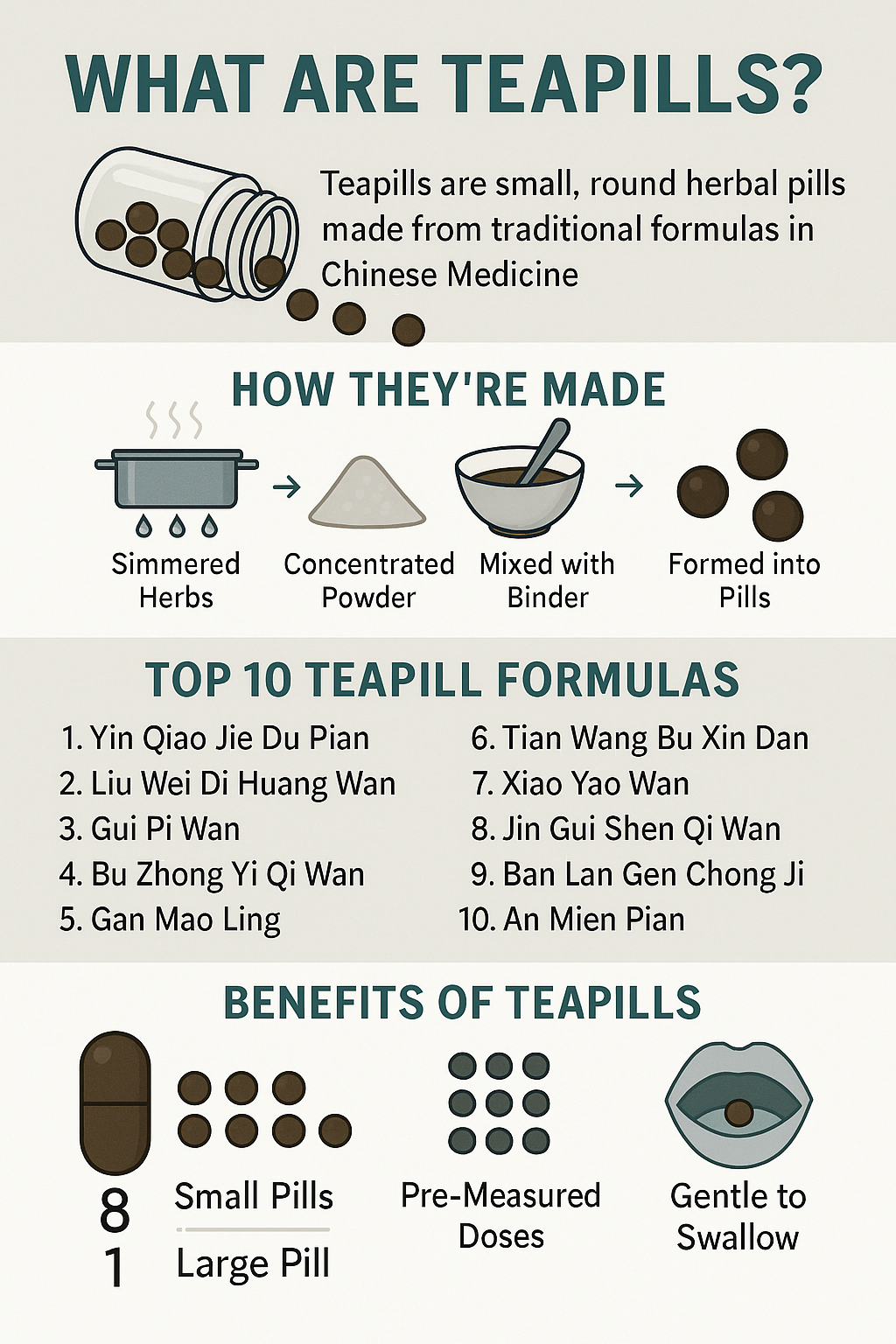The Complete Guide to Chinese Teapills: Uses, Benefits, and the Top 10 Formulas You Should Know
Posted by Sarah Aries Holistic Herbalist on Aug 12th 2025
The Complete Guide to Chinese Teapills: Uses, Benefits, and the Top 10 Formulas You Should Know
What are these traditional black herbal teapills everyone’s curious about?
Chinese teapills are small, round herbal pills made from concentrated Traditional Chinese Medicine formulas. Easy to swallow and portable, they offer consistent dosing, adjustable amounts, and even herbal absorption—making them a convenient, shelf-stable alternative to brewing raw herbs.
What Are Chinese Teapills?
Teapills are tiny, round herbal pills—traditionally black (sometimes brown)—created by concentrating herbal decoctions (herbs simmered in water) into a powder, mixing it with a binding agent like honey or water, and forming them into uniform pellets.
The name “teapill” comes from the centuries-old tradition of preparing herbs as tea before compressing them into pill form. Today, they offer a portable, shelf-stable, and easy-to-use way to take Chinese herbal formulas without brewing raw herbs.
Why People Love Them:
-
Consistent dosage in every serving
-
No brewing, straining, or measuring
-
Portable and discreet
-
Mild taste compared to raw decoctions
 A Brief History of Teapills in TCM
A Brief History of Teapills in TCM
In the Tang Dynasty (618–907 AD), physicians sought ways to preserve herbal formulas for travel and long-term storage. Pills were ideal for caravans, military campaigns, and scholars on the road. Over centuries, teapills became a trusted form of herbal delivery—keeping the exact formula intact and easy to distribute.
Today, teapills are still made using traditional recipes, often under modern Good Manufacturing Practice (GMP) standards, with high-quality herbs tested for purity and potency.
How to Use Teapills
-
Check the label – Serving sizes vary by formula and brand.
-
Take with warm water – Supports digestion and absorption.
-
Timing – Often taken 2–3 times daily; some work best before or between meals.
-
Be consistent – In TCM, regular use over days or weeks often yields the best results.
Why choose teapills over capsules?
Teapills are easier to swallow, allow adjustable dosing, and support even herbal absorption. They preserve the traditional method of delivering Chinese formulas while offering portability and long shelf life.
Who Uses Teapills?
-
Busy professionals – Quick, no-prep herbal support.
-
Travelers – No risk of liquid spills or customs issues.
-
Beginners to Chinese herbs – Gentle introduction without strong tastes.
-
Long-term herbal users – Convenient alternative to daily brewing.
What are the most popular Chinese teapills?
Popular Chinese teapills include Yin Qiao Jie Du Pian, Liu Wei Di Huang Wan, Gui Pi Wan, Bu Zhong Yi Qi Wan, Gan Mao Ling, Tian Wang Bu Xin Dan, Xiao Yao Wan, Jin Gui Shen Qi Wan, Ban Lan Gen Chong Ji, and An Mien Pian.
Are Chinese teapills safe?
Chinese teapills from reputable GMP-certified brands are generally safe for most adults when taken as directed. Always consult a qualified herbalist or healthcare provider before use, especially if pregnant, nursing, or taking medication.
| Rank | Formula | TCM Traditional Function | Why It’s Popular |
|---|---|---|---|
| 1 | Yin Qiao Jie Du Pian | Clears heat, benefits throat comfort | Go-to during seasonal transitions |
| 2 | Liu Wei Di Huang Wan | Nourishes kidney yin | Common daily balance tonic |
| 3 | Gui Pi Wan | Supports qi and blood | Favored for focus and vitality |
| 4 | Bu Zhong Yi Qi Wan | Tonifies spleen, raises qi | Chosen for energy & digestion |
| 5 | Gan Mao Ling | Dispels wind-heat | Often kept as a wellness staple |
| 6 | Tian Wang Bu Xin Dan | Calms spirit, nourishes yin | Trusted for restful nights |
| 7 | Xiao Yao Wan | Harmonizes liver & spleen | A favorite for mood balance |
| 8 | Jin Gui Shen Qi Wan | Warms kidney yang | Popular in cooler months |
| 9 | Ban Lan Gen Chong Ji | Clears heat, benefits throat | Known for ease of use |
| 10 | An Mien Pian | Calms spirit | Chosen for occasional sleeplessness |
Teapills vs. Other Herbal Forms
| Feature | Teapills | Powders/Granules | Tinctures | Raw Herbs |
|---|---|---|---|---|
| Preparation | Ready-to-use | Mix with water | Dropper dose | Boil & strain |
| Taste | Mild | Mild–moderate | Strong | Strong |
| Portability | Excellent | Good | Good | Poor |
| Shelf Life | Long | Long | Moderate | Short (dried herbs) |
| Dosage Flexibility | Good | Excellent | Excellent | Excellent |
Why Many Small Pills Can Be Better Than One Large Pill
When people first see that a teapill serving might be 8 small pills instead of 1 big capsule, their first thought is often: “Why not just make one big pill?”
In Traditional Chinese Medicine (TCM) and in practical everyday use, there are actually several advantages to the smaller, multiple-pill approach.
 1. Easier to Swallow
1. Easier to Swallow
-
Small teapills glide down easily with water, even for those who struggle with large capsules.
-
They’re gentler on the throat and less likely to cause gagging or discomfort.
-
Especially helpful for children, older adults, or anyone with swallowing difficulties.
2. Adjustable Dosing
-
Taking multiple small pills lets you fine-tune your dose.
-
If you’re introducing a new formula, you can start with a partial serving and gradually work up.
-
If you only need a smaller amount for maintenance, you can take fewer pills without having to break open or waste a large capsule.
3. Even Absorption
-
Multiple small pills release their herbal ingredients gradually as they move through digestion.
-
This can support a steadier absorption rate compared to one large dose breaking down all at once.
-
Some people find this gentler on the stomach.
4. Traditional Authenticity
-
The size and style of teapills follow a method used in China for centuries.
-
Maintaining this format preserves the integrity of the original formula and the craftsmanship behind it.
-
Many practitioners believe the smaller size contributes to the way the herbs work synergistically in the body.
5. Portability and Discretion
-
A small handful of tiny pills is easy to carry and take discreetly in public.
-
They don’t require cutting, breaking, or measuring—just count and swallow.
6. Consistency Across Formulas
-
Because many TCM formulas are made in teapill form, the serving style is consistent.
-
If you use more than one formula, you don’t have to adjust to different capsule sizes or dosing styles—making it easier to build a routine.
How to Choose the Right Teapill
-
Identify your main wellness goal (energy, digestion, balance, seasonal support).
-
Choose a trusted supplier with GMP certification.
-
Consider whether you need warming or cooling formulas based on your constitution (TCM concept).
Storage Tips
-
Keep in a cool, dry place.
-
Avoid leaving bottles in hot cars.
-
Close tightly to protect potency.
FAQs About Teapills
Q1: Do teapills work right away?
Teapills are often intended for gradual, steady support. Some formulas may be felt within hours, while others work best with consistent use over days or weeks.
Q2: Can I take teapills with other supplements?
Yes, but check with a qualified herbalist or healthcare provider to avoid interactions.
Q3: How many teapills should I take a day?
Follow the instructions on the label—often 8 pills, 2–3 times daily for adults.
Shop Trusted Teapills
Ready to try teapills? Browse our GMP-certified, lab-tested collection here: Shop All Teapills »
Evidence-Based Support for Small Pills Over Large Ones
1. Easier to Swallow
-
A recent human study examined pill swallowability and found that smaller tablets are significantly easier to swallow. Participants preferred smaller forms and reported fewer difficulties when compared to larger pills.
PMC+2PMC+2ScienceDirect+5PMC+5PMC+5 -
Another study specifically identified that large tablets or capsules pose a substantially higher swallowing difficulty, with a strong link to noncompliance.
PMC
2. Adjustable Dosing
-
The concept of mini-tablets or multi-unit dosage forms supports flexible and precise dosing. One review highlights that dividing a total dose into many small units allows for better dose adjustment and patient compliance—especially pertinent for pediatric and geriatric applications.
PMC+6ResearchGate+6chemisgroup.us+6
3. Even Absorption
-
Research on multi-particulate formulations (tiny particles rather than a single tablet) shows that distributing the dose evenly can support steadier gastric transit and absorption. These formats are designed to provide more consistent pharmacokinetics than large single-unit doses.
arXiv
4. Traditional Authenticity
-
While PubMed doesn’t cover traditional herbal practices directly, regulatory authority documents, such as FDA guidance on dosage form characteristics, affirm that physical format matters for practical use. They note tablets offer ease of administration and accurate dosing—core principles that align with preserved traditional formulations like teapills.
U.S. Food and Drug Administration
5. Overall Compliance & Preference
-
A systematic review highlights that physical attributes—size, shape—significantly influence patient compliance. Smaller, multiparticulate pills typically achieve better patient acceptance.
arXiv+1 -
Another focused review finds that coated, smaller pills are preferred by patients, reinforcing better adherence and fewer swallowing issues.
PMC -
A different investigation into formulations for children and older adults again supports mini-tablets as a more swallowable alternative to conventional large pills.
chemisgroup.us+5PMC+5DrugPatentWatch+5
1. Gan Mao Ling (Common Cold Relief)
Although specific PubMed articles on the traditional Gan Mao Ling formula are limited, related research on Ganmao capsules—similar formulas targeting colds—provides useful insight:
-
Influenza relief: A clinical study showed Ganmao capsules were more effective than amantadine in reducing flu symptoms and accelerating recovery.PMC+15PMC+15Wikipedia+15
-
Formulation quality: A technical study examined alcohol precipitation processes during ganmaoling granule production to optimize retention of active compounds (like linarin).PubMed+2PubMed+2
2. Liu Wei Di Huang Wan (Six-Flavor Rehmannia Pill)
This classic teapill formula has multiple clinical and experimental studies:
-
Herb–drug interaction study: A controlled clinical trial in healthy volunteers found that Liu Wei Di Huang Wan does not significantly alter liver enzyme activities (CYP2C19, CYP2D6, CYP3A4).PubMed+15PubMed+15Wikipedia+15
-
Delayed insulin use in Type 2 diabetes: A large observational study reported that combining LWDHW with oral antidiabetic medications was linked to a lower risk of insulin initiation, showing a dose-dependent benefit.PubMed+2PMC+2
-
Obesity prevention in animal models: In rats fed a high-fat diet, LWDHW significantly reduced body weight, serum triglycerides, leptin, and insulin levels—suggesting anti-obesity potential.PubMed+9PMC+9PMC+9
-
Pharmacology and safety: A comprehensive review outlined LWDHW’s pharmacokinetics, phytochemistry, and safety profile, supporting its use across various conditions.PubMed
-
Immunomodulation in asthma: A study on modified LWDHW demonstrated reduced airway inflammation, altered cytokine profiles, and improved immune responses in an asthma model.PubMed
3. Ban Lan Gen (Isatis Root)
Ban Lan Gen features prominently in antiviral and immunological research:
-
Mechanistic insights in COVID‑19 context: Network pharmacology analysis identified 33 active ingredients in Ban Lan Gen that may act on COVID‑19–related pathways, including IL‑17, TNF, and p53.PubMed+11PubMed+11PMC+11
-
Clinical trial design for influenza: Plans for a randomized, double-blind study evaluating the efficacy and safety of Ban Lan Gen granules against seasonal influenza were outlined, signaling interest in evidence-based validation.PubMed+4PubMed+4PMC+4
-
Chemical composition and activity: A detailed analytical study isolated 88 compounds from Ban Lan Gen with anti-influenza potential, aiding quality control and discovery.PubMed+1
-
Anti-colitis activity via gut microbiota modulation: In a mouse model, Ban Lan Gen granules improved chronic colitis by regulating gut microbiota and enhancing SCFA-mediated GLP-1 release.PubMed
-
Raw material authenticity: A quality study highlighted substitutions in market samples of Daqingye and Ban Lan Gen, emphasizing the need for proper botanical authentication.PubMed
-
Drug metabolism (CYP3A4 induction): One study revealed that indirubin—a Ban Lan Gen component—activated CYP3A4 gene expression in human liver cells, which is important for understanding potential herb–drug interactions.PubMed
Disclaimer: This content is for educational purposes only and is not intended to diagnose, treat, cure, or prevent any disease. Consult a qualified healthcare provider before starting any new herbal supplement.


